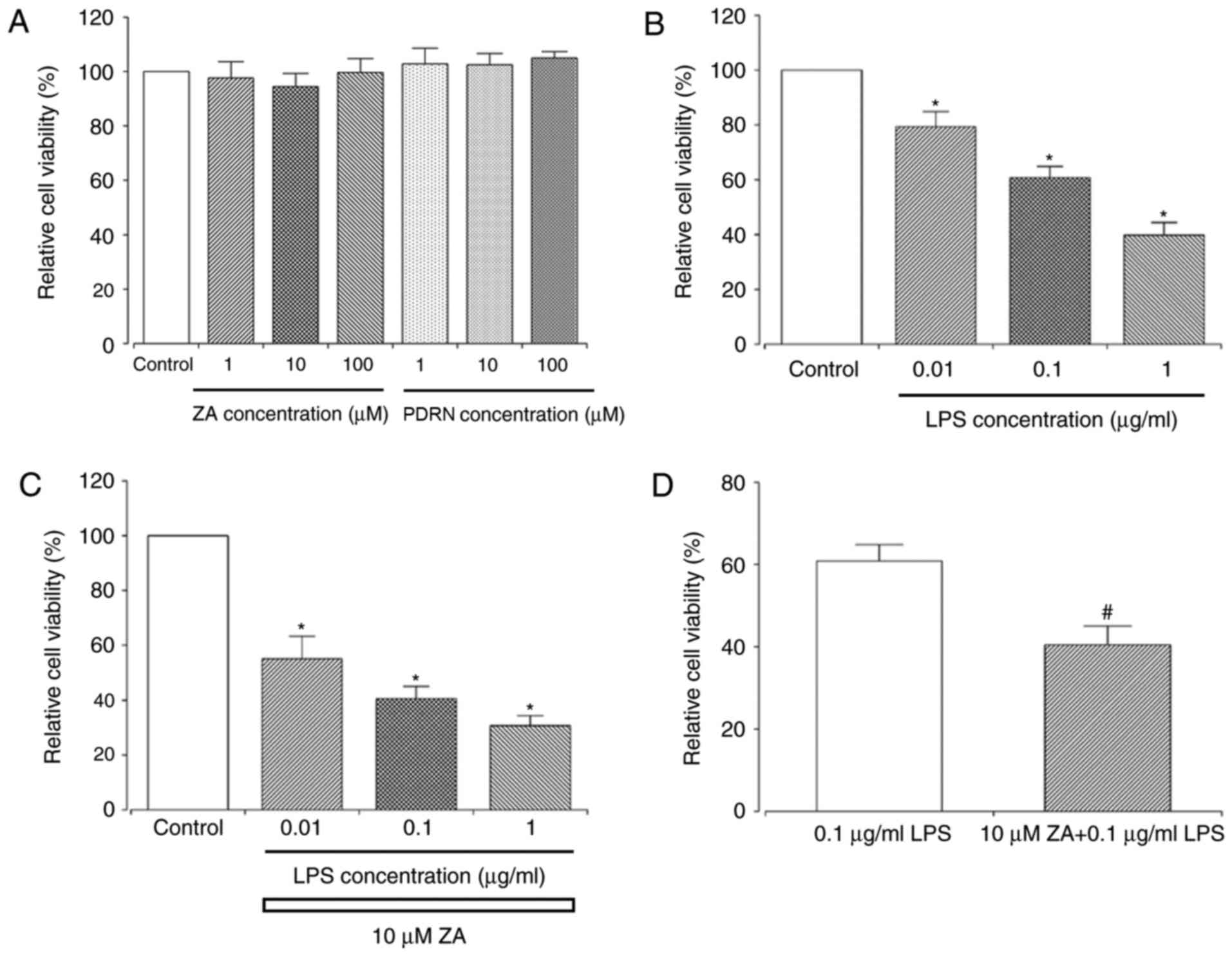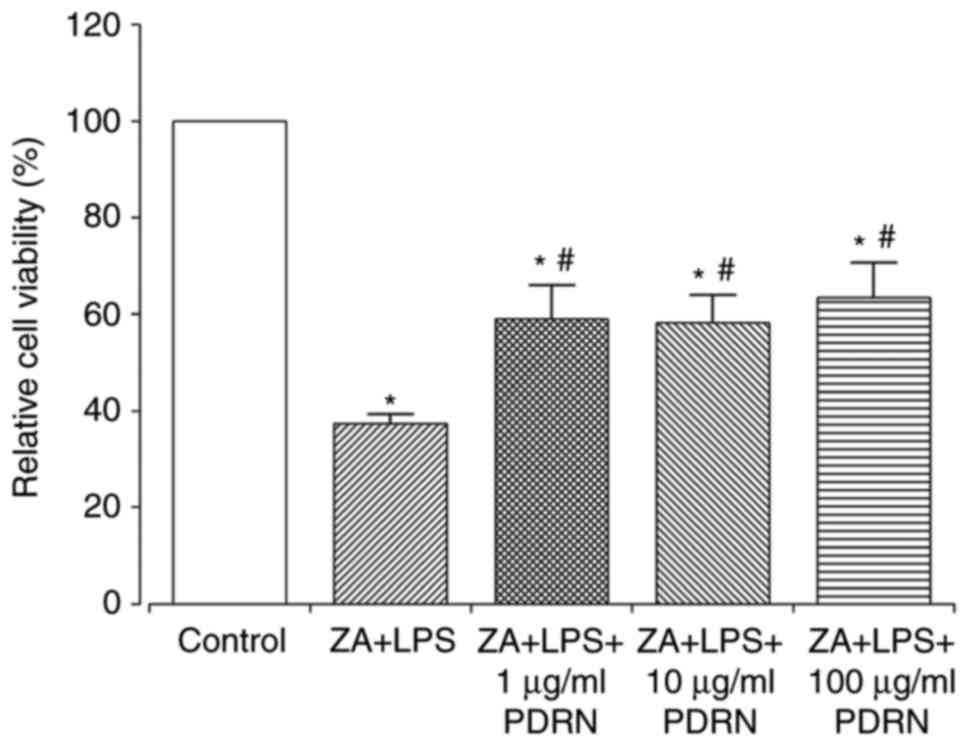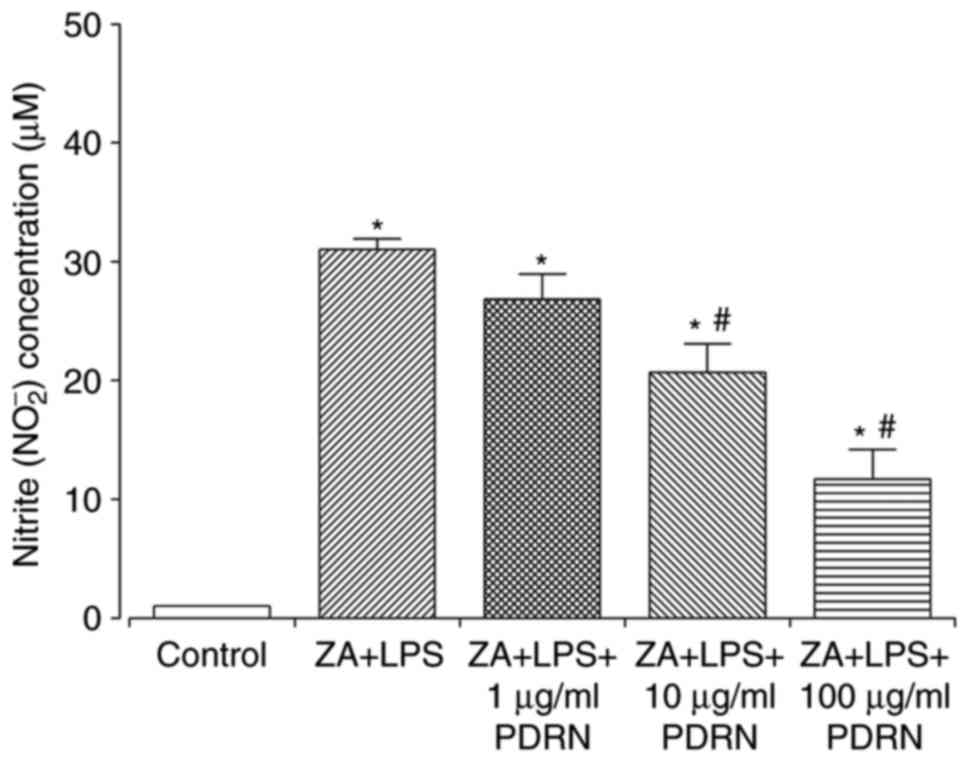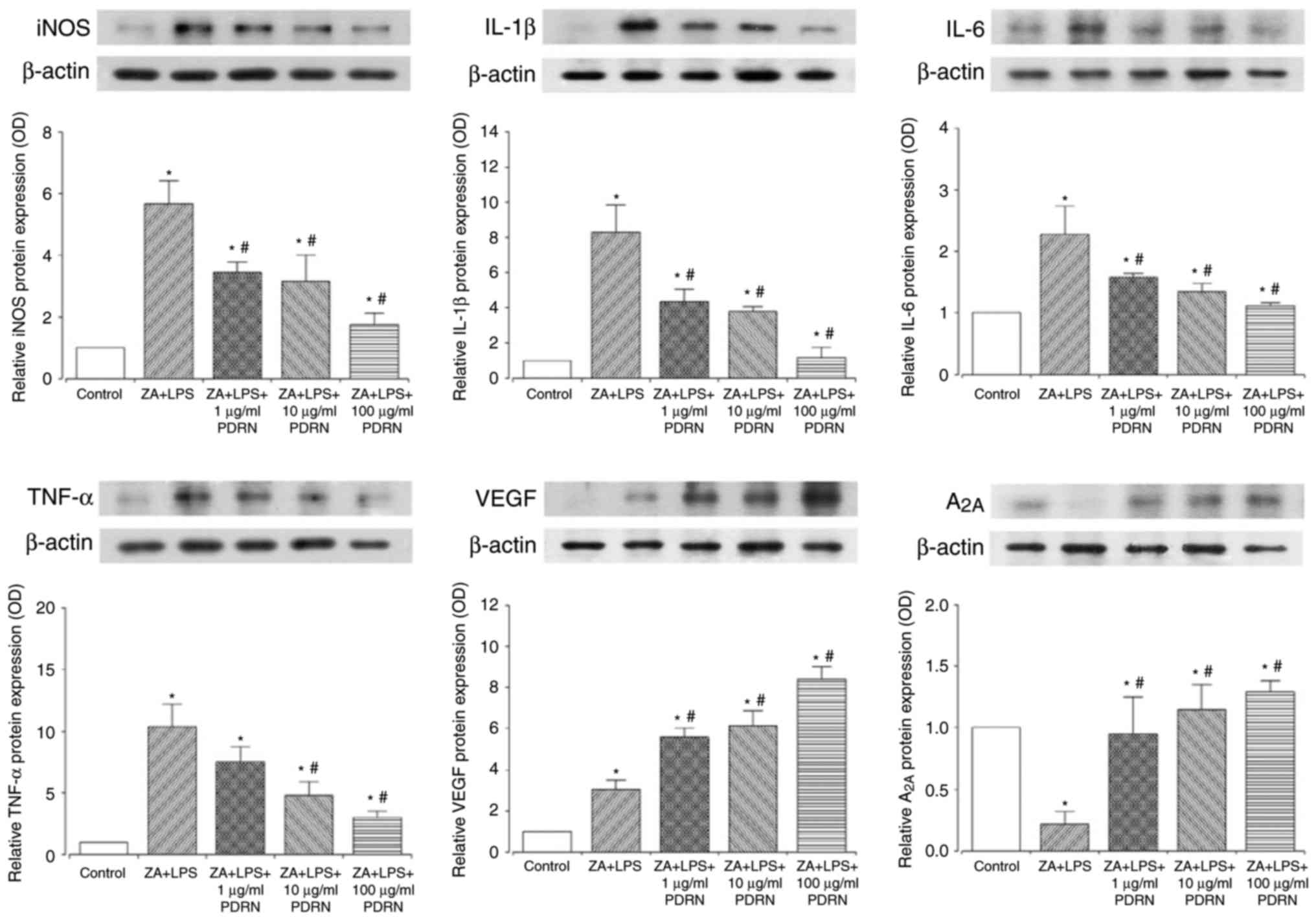Anti‑inflammatory effect of polydeoxyribonucleotide on zoledronic acid‑pretreated and lipopolysaccharide‑stimulated RAW 264.7 cells
- Authors:
- Published online on: May 18, 2018 https://doi.org/10.3892/etm.2018.6186
- Pages: 400-405
Abstract
Introduction
Zoledronic acid (ZA) is a nitrogen-containing bisphosphonate, administered intravenously to treat several bone diseases, including osteoporosis, hypercalcemia, Paget's disease, bone metastasis of a tumor and myeloma (1–3). ZA is selectively accumulated in bone tissue due to its high affinity to bone (4). ZA induces osteoclast apoptosis and consequently inhibits bone resorption as well as bone remodeling (5,6). One of the side effects of bisphosphonates is bisphosphonate-related osteonecrosis of the jaw (BRONJ), first noted in 2003 and now recognized as a well-known complication (7,8). It is occasionally necessary to treat BRONJ, which is associated with the consequent suffering of patients, by performing resective surgery (9). Although the mechanism of action of bisphosphonates in BRONJ remains to be fully understood, the inflammatory process from a bacterial infection and trauma are suspected to cause and intensify the severity of the affliction (10,11).
Lipopolysaccharide (LPS), a component from the cell walls of Gram-negative bacteria, induces immune responses of macrophages, thereby increasing the production of nitric oxide (NO) as well as various cytokines, including tumor necrosis factor (TNF)-α and interleukin (IL)-6 (12,13). NO regulates various pathophysiological processes and its overproduction damages the surrounding tissue resulting in increased inflammation (14). A previous study revealed that the induction of proinflammatory cytokines by LPS is enhanced by pretreatment of ZA and functions due to the reduction of suppressor of cytokine signaling-1 (15).
Polydeoxyribonucleotide (PDRN), consisting of a mixture of deoxyribonucleotide polymers, is easily extracted from the sperm of trout and highly purified by a classified extractive process (16). Following the cleavage of PDRN by active cell membrane enzymes, it provides a source for purine and pyrimidine deoxynucleosides and deoxyribonucleotides (17). Adenosine, a purine nucleoside, activates adenosine A2A receptor and the stimulation of the receptor is suspected to decrease inflammatory cytokine secretion (16,18,19). Previous studies have demonstrated that PDRN significantly reduces the clinical signs of arthritis in mice, by decreasing the circulating levels of several inflammatory cytokines (20) and increasing vascular endothelial growth factor (VEGF) production, indicating decreased ischemic tissue damage and an enhanced oxygen supply (21). Ramanathan et al (22) also reported that the adenosine A2A receptor and LPS increased VEGF expression through transcriptional regulation of the VEGF promoter. VEGF acts as a main regulatory factor for endothelial cell proliferation and increases neovascularization (23). Therefore, VEGF may contribute to enhanced vascularization in BRONJ, which was compromised by increased endothelial cell apoptosis (24). Subsequently, the pathological condition in BRONJ can be improved through increased vascularization with VEGF. Thus, the present study aimed to evaluate whether PDRN regulates the expression of inflammatory cytokines in macrophages pretreated with ZA and LPS.
Materials and methods
Cell culture
The macrophage cell line, RAW 264.7, was purchased from the Korea Cell Line Bank (Korean Cell Line Research Foundation, Seoul, Korea). The cells were maintained in high glucose Dulbecco's modified Eagle's medium (Gibco; Thermo Fisher Scientific, Inc., Waltham, MA, USA) supplemented with 100 µg/ml streptomycin, 100 U/ml penicillin (Lonza Group, Ltd., Basel, Switzerland) and 10% heat-inactivated fetal bovine serum (Gibco; Thermo Fisher Scientific, Inc.) in a 37°C humidified incubator with 5% CO2 for all experiments. At the occurrence of BRONJ, which may be caused by dental procedures or intraoral trauma, bisphosphonates accumulate in bone tissue, subsequently, a bacterial infection occurs and causes an increase in LPS. In the present study, in order to mimic the aforementioned situation, ZA was incubated with RAW 264.7 cells, which were then exposed to LPS. Control cells were maintained without ZA and LPS.
Cell viability analysis
Cytotoxicity was assessed by the MTT assay. RAW 264.7 cells were seeded in 96-well plates at a density of 1×105 cells/well containing 200 µl high glucose DMEM supplemented by 100 µg/ml streptomycin, 100 U/ml penicillin and 10% heat-inactivated fetal bovine serum, and incubated with 1, 10 or 100 µM ZA (Novartis International AG, Basel, Switzerland) for 24 h. The cells were then exposed to 0.01, 0.1 or 1 µg/ml LPS (Sigma-Aldrich; Merck KGaA, Darmstadt, Germany) and various concentrations of PDRN (1, 10 or 100 µg/ml; PharmaResearch Products Co., Ltd., Seongnam, Republic of Korea) in serum free medium at 37°C for 24 h. MTT solution (Sigma-Aldrich; Merck KGaA) was added to a final concentration of 0.5 mg/ml and the plates were incubated at 37°C for 1 h in a humidified incubator. The medium was then removed, the formazan precipitate was solubilized in dimethylsulphoxide and the solution was measured at 570 nm by a microplate reader.
Measurement of NO production
NO production was measured using Nitric oxide (NO) Detection kit (cat. no. 21021; Intron Biotechnology, Sungnam, Republic of Korea). RAW 264.7 cells were plated at a density of 1×105 cells/well in 96-well culture plates and incubated with 10 µM ZA for 24 h at 37°C, followed by exposure to 0.1 µg/ml LPS and various concentrations of PDRN (1, 10 or 100 µg/ml) in serum free medium at 37°C for 24 h. Nitrite levels in the culture medium were measured for NO estimation. The supernatant collected from the culture plate (100 µl) and N1 buffer (50 µl) were added to a new 96-well plate in triplicate. The plate was maintained at room temperature for 10 min, and N2 buffer (50 µl) was subsequently added. The absorbance of the content of each well was measured at a wavelength of 540 nm with a microplate reader. The nitrite concentration was calculated using a nitrite standard curve, according to the manufacturer's protocol.
Western blot analysis of inflammatory factors in whole cell lysate
Cell proteins of RAW 264.7 cells were collected. Briefly, cells were plated at a density of 2×105 cells/dish in a 100 mm culture dish and incubated with 10 µM ZA for 24 h, followed by incubation with 0.1 µg/ml LPS and various concentrations of PDRN (1, 10 or 100 µg/ml) in serum free medium at 37°C for 24 h. Cells were harvested and gently homogenized in radioimmunoprecipitation assay buffer consisting of 20 mM Tris-HCl (pH 7.5), 150 mM NaCl, 1 mM Na2 EDTA, 1 mM EGTA, 1% Nonidet P-40, 1% sodium deoxycholate, 2.5 mM sodium pyrophosphate, 1 mM β-glycerophosphate, 1 mM Na3VO4, 1 µg/ml leupeptin (Cell Signaling Technology, Inc., Danvers, MA, USA) and 1 mM phenylmethylsulfonyl fluoride (Sigma-Aldrich; Merck KGaA). Subsequently, the lysates were incubated for 20 min at 4°C, centrifuged at 16,000 × g for 20 min at 4°C, following which they were rapidly frozen. The lysates were measured for protein quantification using Bio-Rad Protein Assay kit (Bio-Rad Laboratories, Inc., Hercules, CA, USA). A total of 30 µg/lane protein was subjected to western blot analysis using 12% SDS-PAGE gel and transferred to nitrocellulose membrane (GE Healthcare Life Sciences, Little Chalfont, UK). Membranes were incubated in a blocking buffer containing 5% skim milk for 1 h at room temperature. They were subsequently incubated overnight at 4°C with the following primary antibodies: Mouse β-actin, inducible NO synthase (iNOS), TNF-α and VEGF (cat. nos. SC-4778, SC-7271, SC-52746 and SC-7269, respectively), rabbit A2A (cat. no. 13937; all 1:1,000; Santa Cruz Biotechnology Inc., Dallas, TX, USA), IL-1β and IL-6 (cat. nos. bs-6319r and bs-0782r, respectively; both 1:1,000; Bioss Antibodies, Inc., Woburn, MA, USA). The membranes were then incubated at room temperature for 1 h with anti-mouse and anti-rabbit secondary horseradish peroxidase-conjugated antibodies (cat. no. PI-2000 and PI-1000, respectively; both 1:1,000; Vector Laboratories, Inc., Burlingame, CA, USA). Bands were detected using an enhanced chemiluminescence detection kit (Bio-Rad Laboratories, Inc.). Densitrometric analysis of the resultant bands was performed using Molecular Analyst™ software, version 1.4.1 (Bio-Rad Laboratories, Inc.).
Statistical analysis
Statistical analysis was performed using one-way analysis of variance followed by Duncan's post hoc test using SPSS software (version 23.0; IBM Corp., Armonk, NY, USA). Data are expressed as the mean + standard error of the mean. P<0.05 indicated that the difference between groups was statistically significant.
Results
ZA+LPS decreases and PDRN increases cell viability
Single treatment with either ZA or PDRN had no significant effect on the viability of RAW 264.7 cells at any concentration (1, 10 or 100 µM ZA; 1, 10 or 100 µg/ml PDRN; Fig. 1A). However, there was a significant decrease in cell viability when cells were exposed to LPS alone (0.01, 0.1 or 1 µg/ml; Fig. 1B) or ZA+LPS (10 µM ZA + 0.01, 0.1 or 1 µg/ml LPS; Fig. 1C) compared with control cells. Treatment with ZA+LPS (10 µM + 0.1 µg/ml) significantly decreased the cell viability by more than 20% compared with the cells treated with LPS alone (0.1 µg/ml; Fig. 1D). Treatment with 1, 10 or 100 µg/ml PDRN significantly increased cell viability of the ZA+LPS-stimulated RAW 264.7 cells compared with ZA+LPS-stimulated cells (Fig. 2). However, the cell viabilities in ZA+LPS-stimulated cells with or without PDRN treatment were significantly low compared with the control group.
PDRN decreases NO production
ZA+LPS (10 µM + 0.1 µg/ml, respectively)-stimulated RAW 264.7 cells demonstrated significantly enhanced NO production compared with the control group (Fig. 3). NO production significantly decreased in what appeared to be in a dose-dependent manner following 10 and 100 µg/ml of PDRN treatment compared with ZA+LPS-stimulated RAW 264.7 cells.
PDRN decreases the expression of inflammatory cytokines
iNOS, IL-1β, IL-6, and TNF-α inflammatory cytokine expression levels were significantly increased following ZA+LPS-stimulation of RAW 264.7 cells compared with cells in the control group (Fig. 4). However, as PDRN concentration (1, 10 or 100 µg/ml) increased, iNOS expression decreased compared with the ZA+LPS-stimulation of RAW 264.7 cells. Similarly, IL-1β and IL-6 expression significantly decreased following PDRN treatment (1, 10 or 100 µg/ml) compared with ZA+LPS-stimulation of RAW 264.7 cells. Although 1 µg/ml PDRN demonstrated no significant differences, 10 or 100 µg/ml PDRN significantly suppressed TNF-α expression compared with ZA+LPS-stimulated RAW 264.7 cells.
PDRN increases A2A and VEGF expression
VEGF expression was significantly increased by ZA+LPS-stimulation compared with control cells, and the expression was further and significantly increased by PDRN treatment in a marked dose-dependent manner compared with the ZA+LPS-stimulation of RAW 264.7 cells (Fig. 4). PDRN (100 µg/ml) treatment demonstrated the most potent increase in VEGF expression. ZA+LPS-stimulation significantly lowered the expression of A2A compared with the control group. However, the expression of A2A was enhanced by PDRN treatment in what appeared to be a dose-dependent manner compared with control and ZA+LPS-stimulated cells.
Discussion
Several factors are associated with BRONJ, including dental procedures, trauma and inflammation. Previous studies have elucidated the development of BRONJ along with bacterial infection (25–28). LPS, which is found in the cell wall of Gram negative bacteria, induces inflammatory cytokines and NO via nuclear factor-κB activation and NOS. Furthermore, Muratsu et al (15) previously suggested that ZA enhances LPS-stimulated proinflammatory reactions in macrophages, with a consequent increase in LPS-induced apoptosis. PDRN has demonstrated effectiveness in decreasing the circulating levels of several inflammatory cytokines and increasing VEGF production in previous studies (20,21). The present study was therefore undertaken to analyze the effect of PDRN on RAW 264.7 cells pretreated with ZA and stimulated with LPS, by measuring inflammatory mediators.
In the present study, the cell viability of RAW 264.7 was increased by ZA pre-treatment and LPS stimulation. This is due to nitrogen-containing bisphosphonates causing cell apoptosis by inhibiting the mevalonate pathway (4) and LPS stimulation increasing inflammatory cytokine expression levels (15). Notably, the viability of RAW 264.7 cells stimulated by ZA and LPS were significantly enhanced by PDRN treatment.
Western blotting revealed that PDRN treatment significantly decreased the NO production and iNOS expression of RAW 264.7 cells. iNOS catalyzes the synthesis of NO from the amino acid L-arginine as an immune defense mechanism in macrophages; overproduction of NO causes oxidative damage to the surrounding tissue, with a consequent increase of the inflammatory response (29). Furthermore, proinflammatory cytokines, including IL-1β, IL-6 and TNF-α were decreased by PDRN treatment in what appeared to be a dose-dependent manner. Overexpressed TNF-α stimulated the release of free radicals such as NO, inducing cell injury (30,31). Administration of nitrogen-containing bisphosphonate induced the release of IL-1β and IL-6 by macrophages or monocytes, resulting in an acute phase response; one of the known adverse effects of bisphosphonates (32). The results of the current study therefore indicate that PDRN downregulates inflammatory cytokines, and may help in prevention and management of BRONJ.
The present study also demonstrated that PDRN increased A2A receptors and VEGF expression on ZA-pretreated and LPS-stimulated RAW 264.7 cells in what appeared to be a dose-dependent manner. As ZA and LPS induce cell apoptosis, it was hypothesized that adenosine A2A receptor expression decreased in the ZA and LPS-treated cells, and that the expression of the receptor recovered following PDRN treatment. However, the mechanism of the recovered adenosine A2A receptor expression should be further evaluated in a future study. ZA and LPS treatment (10 µM and 0.1 µg/ml, respectively) increase VEGF expression without PDRN. Koide et al (33) suggested that LPS induces VEGF overproduction in macrophages, and Ben-Av et al (34) explained that inflammatory mediators, including IL-1β, prostaglandin E2 and TNF-α, increase VEGF expression.
The activation of adenosine A2A receptors also indicated an increase of VEGF release through the signaling pathways activated by LPS treatment (35). This suggested that PDRN, an A2A receptor agonist, is capable of restoring blood flow and tissue architecture by modulating VEGF expression (36). Additionally, the PDRN-stimulated increase of A2A receptors caused VEGF production during pathological conditions characterized by low tissue perfusion (16,21). Thus, it was hypothesized that PDRN can be used to counteract the inflammatory process inducing osteonecrosis of the jaw. Although other mechanisms may also be involved, these results demonstrate that PDRN increased cell viability and suppressed the inflammatory process.
In conclusion, the present study demonstrated that LPS potently accelerated inflammation in RAW 264.7 cells, following pretreatment with ZA, and that PDRN acted as a suppresser of inflammatory cytokines. Additionally, increased VEGF expression, either directly by PDRN or indirectly by other cytokines and A2A receptors, may have contributed to increased vascularization and subsequently improved the pathological condition of BRONJ. As inflammation and LPS may stimulate the occurrence of BRONJ, the authors of the present study postulated that PDRN is possibly a candidate for the therapeutic management of BRONJ.
Acknowledgements
Not applicable.
Funding
This study was supported by a grant from the National Research Foundation of Korea (grant nos. NRF-2014R1A1A1002630 and NRF-2016R1A2B4014600).
Availability of data and materials
The datasets used and/or analyzed during the current study are available from the corresponding author on reasonable request.
Authors' contributions
J-HH, JJ and LH wrote the manuscript. JJ, LH and I-GK performed the experiments. OHN and MSK analyzed the data. J-HH, JJ, J-WL and B-JC interpreted the data and revised the manuscript. D-WL conceived and managed the study design, and gave final approval of the version to be published.
Ethics approval and consent to participate
Not applicable.
Consent for publication
Not applicable.
Competing interests
The authors declare that they have no competing interests.
Glossary
Abbreviations
Abbreviations:
|
BRONJ |
bisphosphonate-related osteonecrosis of the jaw |
|
PDRN |
polydeoxynucleotide |
References
|
Pennanen N, Lapinjoki S, Urtti A and Mönkkönen J: Effect of liposomal and free bisphosphonates on the IL-1 beta, IL-6 and TNF alpha secretion from RAW 264 cells in vitro. Pharm Res. 12:916–922. 1995. View Article : Google Scholar : PubMed/NCBI | |
|
Berenson JR and Lipton A: Bisphosphonates in the treatment of malignant bone disease. Annu Rev Med. 50:237–248. 1999. View Article : Google Scholar : PubMed/NCBI | |
|
Lipton A: Emerging role of bisphosphonates in the clinic-antitumor activity and prevention of metastasis to bone. Cancer Treat Rev. 34 Suppl 1:S25–S30. 2008. View Article : Google Scholar : PubMed/NCBI | |
|
van Beek ER, Cohen LH, Leroy IM, Ebetino FH, Löwik CW and Papapoulos SE: Differentiating the mechanisms of antiresorptive action of nitrogen containing bisphosphonates. Bone. 33:805–811. 2003. View Article : Google Scholar : PubMed/NCBI | |
|
Pataki A, Muller K, Green JR, Ma YF, Li QN and Jee WS: Effects of short-term treatment with the bisphosphonates zoledronate and pamidronate on rat bone: A comparative histomorphometric study on the cancellous bone formed before, during, and after treatment. Anat Rec. 249:458–468. 1997. View Article : Google Scholar : PubMed/NCBI | |
|
Rogers MJ: New insights into the molecular mechanisms of action of bisphosphonates. Curr Pharm Des. 9:2643–2658. 2003. View Article : Google Scholar : PubMed/NCBI | |
|
Marx RE: Pamidronate (Aredia) and zoledronate (Zometa) induced avascular necrosis of the jaws: A growing epidemic. J Oral Maxillofac Surg. 61:1115–1117. 2003. View Article : Google Scholar : PubMed/NCBI | |
|
Ruggiero SL, Dodson TB, Fantasia J, Goodday R, Aghaloo T, Mehrotra B and O'Ryan F: American Association of Oral and Maxillofacial Surgeons: American Association of oral and maxillofacial surgeons position paper on medication-related osteonecrosis of the jaw-2014 update. J Oral Maxillofac Surg. 72:1938–1956. 2014. View Article : Google Scholar : PubMed/NCBI | |
|
Spinelli G, Torresetti M, Lazzeri D, Zhang YX, Arcuri F, Agostini T and Grassetti L: Microsurgical reconstruction after bisphosphonate-related osteonecrosis of the jaw: Our experience with fibula free flap. J Craniofac Surg. 25:788–792. 2014. View Article : Google Scholar : PubMed/NCBI | |
|
Tsurushima H, Kokuryo S, Sakaguchi O, Tanaka J and Tominaga K: Bacterial promotion of bisphosphonate-induced osteonecrosis in Wistar rats. Int J Oral Maxillofac Surg. 42:1481–1487. 2013. View Article : Google Scholar : PubMed/NCBI | |
|
Hoff AO, Toth BB, Altundag K, Johnson MM, Warneke CL, Hu M, Nooka A, Sayegh G, Guarneri V, Desrouleaux K, et al: Frequency and risk factors associated with osteonecrosis of the jaw in cancer patients treated with intravenous bisphosphonates. J Bone Miner Res. 23:826–836. 2008. View Article : Google Scholar : PubMed/NCBI | |
|
Xie C, Kang J, Li Z, Schauss AG, Badger TM, Nagarajan S, Wu T and Wu X: The açaí flavonoid velutin is a potent anti-inflammatory agent: Blockade of LPS-mediated TNF-α and IL-6 production through inhibiting NF-κB activation and MAPK pathway. J Nutr Biochem. 23:1184–1191. 2012. View Article : Google Scholar : PubMed/NCBI | |
|
Nicholas C, Batra S, Vargo MA, Voss OH, Gavrilin MA, Wewers MD, Guttridge DC, Grotewold E and Doseff AI: Apigenin blocks lipopolysaccharide-induced lethality in vivo and proinflammatory cytokines expression by inactivating NF-kappaB through the suppression of p65 phosphorylation. J Immunol. 179:7121–7127. 2007. View Article : Google Scholar : PubMed/NCBI | |
|
Taira J, Nanbu H and Ueda K: Nitric oxide-scavenging compounds in Agrimonia pilosa Ledeb on LPS-induced RAW264.7 macrophages. Food Chem. 115:1221–1227. 2009. View Article : Google Scholar | |
|
Muratsu D, Yoshiga D, Taketomi T, Onimura T, Seki Y, Matsumoto A and Nakamura S: Zoledronic acid enhances lipopolysaccharide-stimulated proinflammatory reactions through controlled expression of SOCS1 in macrophages. PLoS One. 8:e679062013. View Article : Google Scholar : PubMed/NCBI | |
|
Altavilla D, Bitto A, Polito F, Marini H, Minutoli L, Di Stefano V, Irrera N, Cattarini G and Squadrito F: Polydeoxyribonucleotide (PDRN): A safe approach to induce therapeutic angiogenesis in peripheral artery occlusive disease and in diabetic foot ulcers. Cardiovasc Hematol Agents Med Chem. 7:313–321. 2009. View Article : Google Scholar : PubMed/NCBI | |
|
Squadrito F, Bitto A, Altavilla D, Arcoraci V, De Caridi G, De Feo ME, Corrao S, Pallio G, Sterrantino C, Minutoli L, et al: The effect of PDRN, an adenosine receptor A2A agonist, on the healing of chronic diabetic foot ulcers: Results of a clinical trial. J Clin Endocrinol Metab. 99:E746–E753. 2014. View Article : Google Scholar : PubMed/NCBI | |
|
Gomez G and Sitkovsky MV: Targeting G protein-coupled A2a adenosine receptors to engineer inflammation in vivo. Int J Biochem Cell Biol. 35:410–414. 2003. View Article : Google Scholar : PubMed/NCBI | |
|
Cronstein BN: Adenosine, an endogenous anti-inflammatory agent. J Appl Physiol (1985). 76:5–13. 1994. View Article : Google Scholar : PubMed/NCBI | |
|
Bitto A, Polito F, Irrera N, D'Ascola A, Avenoso A, Nastasi G, Campo GM, Micali A, Bagnato G, Minutoli L, et al: Polydeoxyribonucleotide reduces cytokine production and the severity of collagen-induced arthritis by stimulation of adenosine A(2A) receptor. Arthritis Rheum. 63:3364–3371. 2011. View Article : Google Scholar : PubMed/NCBI | |
|
Jeong EK, Jang HJ, Kim SS, Lee SY, Oh MY, Kim HJ, Eom DW, Ham JY and Han DJ: Protective effect of polydeoxyribonucleotide against renal ischemia-reperfusion injury in mice. Transplant Proc. 48:1251–1257. 2016. View Article : Google Scholar : PubMed/NCBI | |
|
Ramanathan M, Pinhal-Enfield G, Hao I and Leibovich SJ: Synergistic up-regulation of vascular endothelial growth factor (VEGF) expression in macrophages by adenosine A2A receptor agonists and endotoxin involves transcriptional regulation via the hypoxia response element in the VEGF promoter. Mol Biol Cell. 18:14–23. 2007. View Article : Google Scholar : PubMed/NCBI | |
|
Ferrara N, Gerber HP and LeCouter J: The biology of VEGF and its receptors. Nat Med. 9:669–676. 2003. View Article : Google Scholar : PubMed/NCBI | |
|
Ziebart T, Pabst A, Klein MO, Kämmerer P, Gauss L, Brüllmann D, Al-Nawas B and Walter C: Bisphosphonates: Restrictions for vasculogenesis and angiogenesis: Inhibition of cell function of endothelial progenitor cells and mature endothelial cells in vitro. Clin Oral Investig. 15:105–111. 2011. View Article : Google Scholar : PubMed/NCBI | |
|
Naik NH and Russo TA: Bisphosphonate-related osteonecrosis of the jaw: The role of actinomyces. Clin Infect Dis. 49:1729–1732. 2009. View Article : Google Scholar : PubMed/NCBI | |
|
Ikeda T, Kuraguchi J, Kogashiwa Y, Yokoi H, Satomi T and Kohno N: Successful treatment of bisphosphonate-related osteonecrosis of the jaw (BRONJ) patients with sitafloxacin: New strategies for the treatment of BRONJ. Bone. 73:217–222. 2015. View Article : Google Scholar : PubMed/NCBI | |
|
Boff RC, Salum FG, Figueiredo MA and Cherubini K: Important aspects regarding the role of microorganisms in bisphosphonate-related osteonecrosis of the jaws. Arch Oral Biol. 59:790–799. 2014. View Article : Google Scholar : PubMed/NCBI | |
|
Sakaguchi O, Kokuryo S, Tsurushima H, Tanaka J, Habu M, Uehara M, Nishihara T and Tominaga K: Lipopolysaccharide aggravates bisphosphonate-induced osteonecrosis in rats. Int J Oral Maxillofac Surg. 44:528–534. 2015. View Article : Google Scholar : PubMed/NCBI | |
|
Burney S, Caulfield JL, Niles JC, Wishnok JS and Tannenbaum SR: The chemistry of DNA damage from nitric oxide and peroxynitrite. Mutat Res. 424:37–49. 1999. View Article : Google Scholar : PubMed/NCBI | |
|
Makkonen N, Hirvonen MR, Teräväinen T, Savolainen K and Mönkkönen J: Different effects of three bisphosphonates on nitric oxide production by RAW 264 macrophage-like cells in vitro. J Pharmacol Exp Ther. 277:1097–1102. 1996.PubMed/NCBI | |
|
Kobayashi Y: The regulatory role of nitric oxide in proinflammatory cytokine expression during the induction and resolution of inflammation. J Leukoc Biol. 88:1157–1162. 2010. View Article : Google Scholar : PubMed/NCBI | |
|
Adami S, Bhalla AK, Dorizzi R, Montesanti F, Rosini S, Salvagno G and Lo Cascio V: The acute-phase response after bisphosphonate administration. Calcif Tissue Int. 41:326–331. 1987. View Article : Google Scholar : PubMed/NCBI | |
|
Koide N, Odkhuu E, Naiki Y, Tsolmongyn B, Ito K, Komatsu T, Yoshida T and Yokochi T: Augmentation of LPS-induced vascular endothelial cell growth factor production in macrophages by transforming growth factor-β1. Innate Immun. 20:816–825. 2014. View Article : Google Scholar : PubMed/NCBI | |
|
Ben-Av P, Crofford LJ, Wilder RL and Hla T: Induction of vascular endothelial growth factor expression in synovial fibroblasts by prostaglandin E and interleukin-1: A potential mechanism for inflammatory angiogenesis. FEBS Lett. 372:83–87. 1995. View Article : Google Scholar : PubMed/NCBI | |
|
De Ponti C, Carini R, Alchera E, Nitti MP, Locati M, Albano E, Cairo G and Tacchini L: Adenosine A2a receptor-mediated, normoxic induction of HIF-1 through PKC and PI-3K-dependent pathways in macrophages. J Leukoc Biol. 82:392–402. 2007. View Article : Google Scholar : PubMed/NCBI | |
|
Polito F, Bitto A, Galeano M, Irrera N, Marini H, Calò M, Squadrito F and Altavilla D: Polydeoxyribonucleotide restores blood flow in an experimental model of ischemic skin flaps. J Vasc Surg. 55:479–488. 2012. View Article : Google Scholar : PubMed/NCBI |













